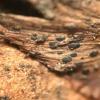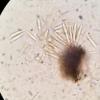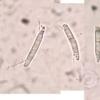
15-11-2025 23:22
Mario FilippaHello,this is what I think to be Hymenoscyphus mac

14-11-2025 16:26
 Marian Jagers
Marian Jagers
Hello everyone, On dead wood of Cytisus scoparius

15-11-2025 20:25
 Riet van Oosten
Riet van Oosten
Hello, Found by Laurens van der Linde, Nov. 2025

14-11-2025 18:31
 Lothar Krieglsteiner
Lothar Krieglsteiner
Hello,can somebody provide me with a file of:Rothe

12-11-2025 09:25
 Viktorie Halasu
Viktorie Halasu
Hello, I need help with a pale terrestric Pseudom

11-11-2025 20:16
Bohan JiaHi, lastly I have found these tiny yellow decayin

09-11-2025 13:20
Hello.A tiny ascomycete, appearing as erupting gra
On Pseudotsuga cones, Discosia pini ? - Discosia strobilina ?
Ethan Crenson,
23-03-2021 06:34
Hello all,
I found these black pycnidia of an imperfect asco growing on a cone of Pseudotsuga menziesii in a cemetery/arboretum in Brooklyn, New York, US. I believe these belong to the genus Discosia, but I'm uncertain of the species.
The pycnidia are black, lightly striate, elliptical, flat, sometimes with a pore or ostiole developing in the center. They are smaller than 1mm in length.
The conidia are hyaline, fusiform, 3-septate, usually with 2 long setulae emerging from one side of the conidiospore near the outer septa. Many of the conidia I observed had deformed outer cells as though those cells were deflated or malformed. I'm not sure if that is an important feature or if it's an anomoly caused by environmental factors. Conidia size: (14.5) 18-20 x 3µm, the setulae range from 5-14µm in length. The conidia were almost uniformly 3µm wide, without any variation.
Because of the substrate, two possibilities may be Discosia pini and Discosia strobilinia. But I don't have any experience with this genus, so hopefully someone can help.
Many thanks in advance,
Ethan
Bernard Declercq,
23-03-2021 15:00

Re : On Pseudotsuga cones, Discosia pini ? - Discosia strobilina ?
Hi Ethan,
Compare with D. strobilina which has conidia with the lower middle cell longer than the upper one. D. pini has middle cells of about the same length.
Bernard
Compare with D. strobilina which has conidia with the lower middle cell longer than the upper one. D. pini has middle cells of about the same length.
Bernard
Ethan Crenson,
23-03-2021 15:27
Re : On Pseudotsuga cones, Discosia pini ? - Discosia strobilina ?
Thank you Bernard! D. strobilina--I think you're right. At a glance the middle cells are quite different in length. Is the deformation of the outer cells anything to consider, or just an anomoly? (I have seen it happen to Bertia moriformis spores as well.) And is there a recent paper I can find about Discosia?
Ethan


